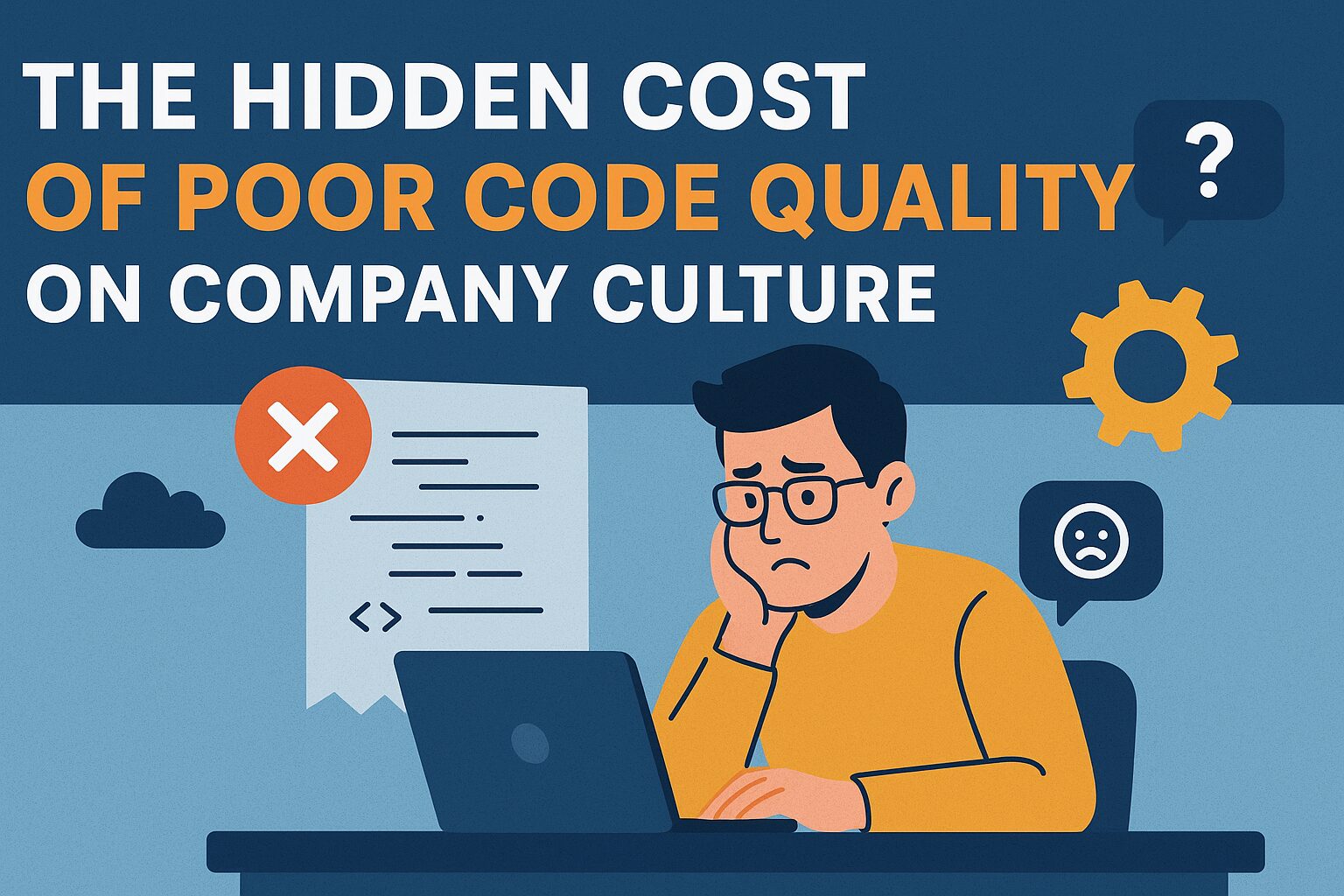When businesses discuss the impact of poor code quality, the conversation often revolves around technical debt, bugs, and maintenance costs. While these are valid concerns, there’s a deeper, less tangible consequence that often goes unnoticed — the toll poor code takes on company culture. Beyond performance issues and delayed projects, messy, inconsistent, or unreliable code can quietly erode morale, collaboration, and trust within a development team. Over time, it shapes how people think, communicate, and even feel about their work.
Let’s uncover how poor code quality impacts not just your systems, but also your people — and what companies can do to reverse that effect.
1. The Daily Frustration: Developer Morale Takes a Hit
Developers spend much of their time reading, maintaining, and debugging existing code rather than writing new features. When that code is messy, undocumented, or inconsistent, it turns what should be creative problem-solving into an exercise in frustration.
Imagine starting your day trying to fix a feature, only to find that the logic is scattered across multiple files with no clear structure. It’s not just inefficient — it’s demotivating. Over time, this frustration builds up, leading to burnout, decreased productivity, and high turnover rates.
Poor code quality sends an unspoken message: “Speed matters more than craftsmanship.” This undermines developer pride and discourages a sense of ownership, key ingredients in a healthy, motivated tech team.
2. Collaboration Suffers: Silos and Blame Culture Emerge
Clean, well-documented code acts as a shared language among developers. It allows anyone to understand and build upon someone else’s work. Poor-quality code, on the other hand, isolates individuals. Developers become overly dependent on the original author’s explanations, leading to bottlenecks and communication breakdowns.
When projects fail or bugs arise, finger-pointing often replaces problem-solving. “Who wrote this?” becomes a more common question than “How do we fix this?” Over time, this fosters a blame-oriented culture where collaboration gives way to defensiveness.
Team members become reluctant to take risks, fearing that their work might be criticized or misunderstood. This not only reduces innovation but also damages trust — a cornerstone of any strong company culture.
3. Innovation Slows Down: Fear of Change Creeps In
In high-quality codebases, developers are confident making changes, experimenting with new ideas, and iterating quickly. Poor-quality code reverses that confidence. Every change feels risky, every update threatens to break something else, and every deployment is accompanied by anxiety.
This fear of breaking things creates a culture of hesitation. Teams stop innovating and instead focus on avoiding mistakes. Technical stagnation sets in — not because the company lacks ideas, but because the code itself has become a barrier to progress.
When developers spend more time cleaning up messes than building new features, innovation takes a back seat. The company’s competitive edge begins to dull, not from lack of talent, but from a lack of technical clarity.
4. Poor Code Reflects Poor Communication
Code is a form of communication. It’s how developers share their thought process and intent with others on the team. Sloppy, inconsistent, or overly complex code is often a reflection of poor communication habits within the team.
A culture that doesn’t prioritize code reviews, documentation, or standards usually suffers from the same issues in meetings and strategy discussions — unclear expectations, misaligned goals, and confusion about responsibilities.
Improving code quality often starts with improving communication. When teams talk openly about standards, share feedback through reviews, and collaborate on improvements, they build both better software and stronger relationships.
5. Onboarding Becomes a Nightmare
For new developers, onboarding into a codebase should be an exciting learning experience. But when the existing code is a tangled mess, it quickly becomes overwhelming. Instead of learning the system’s logic, new hires spend weeks (or months) trying to understand unstructured, poorly documented code.
This delay affects their confidence and sense of belonging. They may begin to feel isolated, unproductive, or even question their skills. Over time, high onboarding friction contributes to employee churn, especially among early-career developers who crave mentorship and clarity.
A company that values code quality creates a smoother learning curve, helping new developers integrate faster and feel part of a unified engineering culture.
6. Business Reputation and Team Pride Decline
Just as employees take pride in their office environment, they also take pride in the quality of the systems they build. Working on a high-quality product that’s well-engineered boosts morale and motivation. Conversely, working on a fragile, bug-ridden system breeds embarrassment and disengagement.
If poor code quality becomes the norm, it doesn’t just affect internal culture — it can damage the company’s external reputation as well. Word travels fast in the developer community, and companies known for sloppy engineering practices struggle to attract top talent. Eventually, technical debt turns into cultural debt, and both can be extremely hard to repay.
7. Turning the Tide: Building a Culture of Quality
The good news is that poor code quality is not irreversible. It requires conscious cultural and managerial effort to prioritize quality at every level of the organization.
Here’s how companies can start:
- Promote code reviews as learning opportunities, not judgment sessions.
- Adopt coding standards that are agreed upon by the whole team.
- Invest in continuous integration and testing tools to prevent future regressions.
- Encourage refactoring time as part of regular development cycles.
- Recognize developers who improve maintainability, not just those who deliver quickly.
When leaders champion code quality as part of the company’s values, it sends a strong signal that excellence and teamwork matter just as much as deadlines and deliverables.
Conclusion
Poor code quality is more than a technical issue — it’s a cultural one. It drains morale, breeds frustration, and creates invisible barriers between talented people who should be working together. By investing in clean, maintainable, and thoughtful code, companies don’t just improve their software — they strengthen the culture that builds it.
At the end of the day, high-quality code is not just about better performance; it’s about creating an environment where developers thrive, collaborate, and innovate with confidence.







